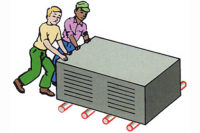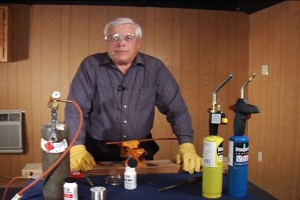The dispatcher calls and tells Bob to go to a business that has a cooling complaint. The customer's building is warmer than normal.
Bob arrives and talks to the manager. She explains to Bob, "The thermostat is set at 72 degrees but the temperature is 76 degrees. It also feels very humid in the building."
Bob notes that it is 96 degrees outside, but the system should do better than this.
The manager walks him to the equipment room down the hall and shows him the equipment. She says, "The rest of the equipment is on the roof."
She leaves Bob to investigate the problem. He notices right away that there are two coils in the air handler because there are two thermostatic expansion valves (TXVs). He also notices there are two solenoid valves, one just before each expansion valve. Bob has never worked on a system like this, so he is looking it over carefully. He notices a ladder and a roof hatch to get onto the roof, so he decides to go up there and see if he notices anything that is different. He notices the compressor is running, so he removes the panel to the compressor and feels around on the compressor. The compressor seems to be running well and feels normal. He is standing there scratching his head when Btu Buddy asks, "Got a problem?"
Bob explains, "Everything seems normal, but the conditioned space is too warm and humid. The compressor is running and looks normal. I am going to put gauges on the compressor."
Bob fastens his gauges to the compressor. The suction pressure is 74 psig and the head pressure is 185 psig. Bob then says, "The suction pressure is a little high and the head pressure is a little low. This looks like a bad compressor to me."
Btu Buddy then tells Bob, "See what the amperage is on the compressor."
Bob checks the amperage and reports it to be 55 amps.
Btu Buddy then asks, "What is the full load amperage on the compressor nameplate?"
Bob looks and says, "It is 100 amps full load. This verifies the compressor is not doing its job. It must have some cylinders that are no good."
Btu Buddy then says, "You are not familiar with a system like this. Let's go to the equipment room and do some checking."

EXPLAINING CAPACITY CONTROL
When they move downstairs, Btu Buddy begins an explanation. "This system has capacity control. The total pumping capacity of the compressor and the rest of the system is 50 tons; however, it is capable of operating at several different capacities when needed. For example, it is the middle of the day and the load on the conditioned space is higher than normal. If you noticed, the compressor has eight cylinders; 50 tons divided by 8 equals 6.25 tons per cylinder. The manufacturer has a method of unloading the cylinders so the system can operate at reduced capacity at reduced loads. For example, in the morning, the unit may only have a capacity of 25 tons when it starts up. Suppose the compressor could be made to run at 25 tons by operating on four cylinders (6.25 x 4 = 25 tons)?"Bob says, "That really sounds good. How can the compressor unload on demand?"
Btu Buddy then says, "Using a two-cylinder compressor as an example, what would happen if we could hold open one of the suction valves on one of the cylinders?"
Bob says, "Gosh, I don't know."
Btu Buddy says, "When the piston goes down on the suction stroke, what would happen?"
Bob answers, "The cylinder would fill with suction gas."
"Good," says Btu Buddy. "Now with the suction valve held open, when the piston comes back up for the compression stroke, it will push that suction gas right back out into the suction line. No work has been accomplished except overcoming friction (Figure 1)."
Bob says, "With no work accomplished, the current draw or amperage would go down."
Btu Buddy says, "That is correct. Also, it is worth noting that the cool suction gas drawn into the cylinder will keep the cylinder cool and lubricate it, so it can run for long periods of time under these conditions. Now, let's talk about this system. When we want the system to run at reduced capacity, we merely need to shut off the refrigerant flow to one of the coils to reduce the flow capacity by half. The compressor has what is called suction pressure unloaders, meaning they are sensitive to suction pressure. When the suction pressure is reduced, the compressor will automatically unload to maintain the approximate suction pressure."

Btu Buddy explains, "Before you change the valve, check to make sure there is voltage to it. This could also be a thermostat problem."
Bob checks the voltage and it is 115 volts, the control voltage for this system. Then he says, "There is voltage. The solenoid coil is defective."
Bob goes to the supply house and gets a new coil for the valve. He shuts off the power and changes the coil (Figure 2).
Bob then turns the power back on and starts the system. He goes to the roof and checks the amperage on the compressor and it is drawing full load amperage. He turns to Btu Buddy and says, "Thanks for walking me through that one. I don't know when I would have figured it out on my own."
Btu Buddy then notes, "The reason that the humidity seemed so high in the office space was the bottom coil solenoid was the one that failed. The top coil was working, taking moisture out of the air, but that moisture was running down over the bottom coil with the air flowing over it, evaporating most of the moisture back into the conditioned space. In this type of system, the lower evaporator is the first stage, the first on and last off, and the upper evaporator is the second stage, last on and first off on the thermostat. Always remember that and don't get them reversed or the system will re-evaporate moisture into the conditioned space if the bottom evaporator shuts off and the top evaporator is still operating."
Bob says, "Well, another lesson. Thanks."
As they are leaving the job, Btu Buddy says, "The manager was really pleased that you got to the bottom of that call in good time and it didn't cost too much. I think you have another satisfied customer."
Publication date: 09/18/2006








